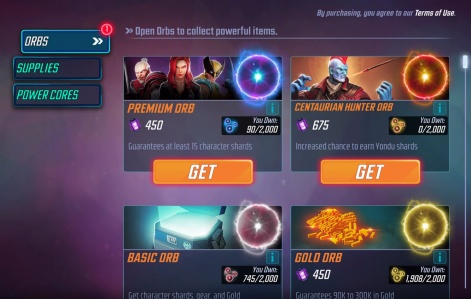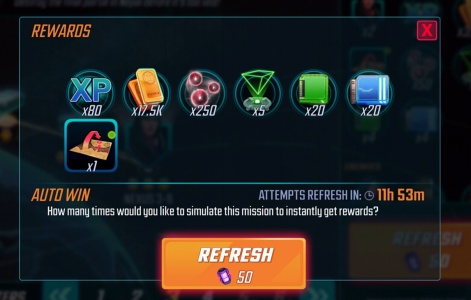Welcome back to the In-App Purchase Inspector – our regular look at free-to-play games from the consumer's perspective.
In each instalment, we consider the incentives or pressure applied to make in-app purchases, their perceived value, the expansion offered by IAPs, and the overall value of the experience.
This time we're looking at FoxNext’s superhero squad RPG Marvel Strike Force.
The power of Power Cores
In many ways, Marvel Strike Force is a conventional squad-based F2P mobile RPG. It doesn’t look to reinvent the wheel and this is broadly reflected in the structure of its in-game economy.
The main - hard - currency are Power Cores, which are the only in-game currency that can purchased with real money. $1.99 will get you 150, while $99.99 nets 8,630. Power Cores are used to gain access to all other items and resources in the game.
Most notable in this regard is gaining access to the shards used to unlock and level up characters. Strike Force offers players a large selection of Marvel superheroes and supervillains - currently 64, with more to come.

The other main currency is the soft currency Gold. This is also used to level up characters, but in a different way to shards.
Every F2P game needs a loot box system and in Marvel Strike Force, this is the Orb system.
Shards are specific to a character and required to increase their star ranking. In addition, you need to level up or train your characters using training modules and gold, and increase their gear tier.
Gearing up requires the collection of specific items although most items can be applied across multiple characters as opposed to being locked to an individual as with shards. As well as being used in training, you can also use gold to purchase specific gear items in the store.
Gotta have gacha
Of course, every F2P game needs a loot box system. In Marvel Strike Force, this is the Orb system.
There are different types of orbs, which drop different types of items. Each orb drops three items. The most expensive orbs drop a combination of guaranteed character shards and some random shards, while cheaper orbs drop random shards, gold and gear items. There are also orbs which drops gold, orbs which drop training modules, and orbs which drop ability materials.

Ability materials make up the final part of each character’s levelling system. They are used to increase the power of each character’s abilities, typically their attacks but also including passive abilities and buffs/debuffs.
Rewards through Alliance
So far, so textbook you might be thinking, but Marvel Strike Force does break out against conventionality in some ways.
The most significant is the way it deals with Alliances, which offers an entirely separate play mode, Alliance Raids, and in-app economy.
A survival-style mode, this requires its own raid energy system, which as with the main campaign energy system recharges over time or can be instantly recharged by spending power cores.

Also linking into alliance activity are Ultimus Keys, which are required in order to launch Alliance Raids in the first place. Each unit of campaign energy spent earns you one Ultimus key. Your performance in raids is rewarded with Raid Credits (amongst other items), which can be spent to purchase orbs and supplies in the Alliance Store.
Where the game does stand out is in its sheer generosity.
Indeed, a similar system also operates in terms of Arena Credits, which are earned by your performance in the PVP arena and spent in the Arena Store,
Giving it all away
In conclusion, Marvel Strike Force offers a standard F2P mobile in-game economy, albeit one broadly split into two separate systems; one for the Campaign mode and one for the Alliance mode.
Where the game does stand out, however, is in its sheer generosity.
Unless you really want to speed through content, unlock and level up a specific character, or fulfill some other self-imposed target, there is no need to spend money.
In that respect, developer FoxNext Games really seemed to be focused on player retention, something underlined by giving away high profile character Wolverine to players who complete the game’s Daily Objectives seven times.





















